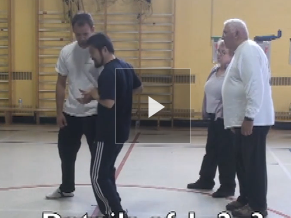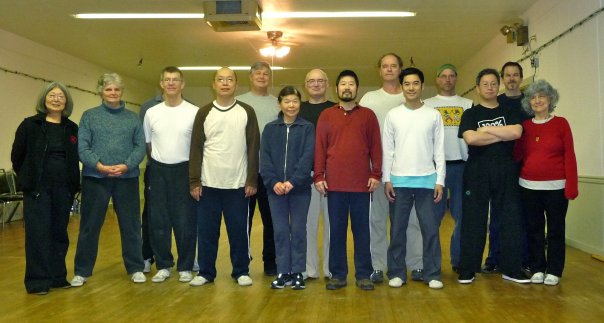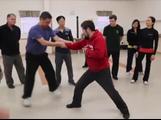At lunch Master Chen compared learning Taiji to boiling water: The requirement for boiling water is 100 degrees, even if the water is 99 degrees it is still not boiling. From one perspective the water might as well still be cold because it is still not boiling; 99 degrees might as well be 1 degree. In reality 99 degrees is only 1 degree away from boiling while 1 degree is still 99 degrees away from boiling. Read more
Knowledge : Principle-Concept
Master Chen said there are many things he can’t do which would give the impression that he is not very flexible. But, he insists, his joints are round and smooth which means he can maneuver them freely. Maneuverability is favored over looseness. If you are not stiff, you have no power. If your joints are not round you have no maneuverability.
When we learn the form we must copy what we see. This is not wrong. Form means to get from here to there. What’s wrong is how we get there, the way we do it. The form must look the same but the action must be exactly the opposite of what you would come up with on your own.
The size of movement of each part of the body must match. For example the hand is capable of a much wider range of motion than the body, therefore the hand can only be allowed to move as much as the body does.
Today Master Chen reinforced a point of Push Hands with me. All the lessons that have been mentioned in class lately and our last weekend Seminar is to look for a line and Read more
Here is something that I shared with a friend today.
- Learn principles, not techniques. Read more
YouTube – Size of Circles. By Chen Zhonghua. Filmed in Holland in 2008. This is a clip from hunyuantaiji on youtube.
YouTube – Chen and Calandra Taiji Applications. Master Chen Zhonghua and Michael Calandra explained some of the Cannon Fist techniques in this video clip. The setting was in Master Calandra’s dojo in Queen, NY in 2003 at a workshop on Cannon Fist of Chen Style Taijiquan Practical Method.

No Trailer
By: Chen Zhonghua陈中华. Length: 3:08 minutes分钟. Year: 2010年. Language: English英文.
This is a video clip from Master Chen Zhonghua’s May 2010 Montreal workshop. It gives instructions on the application sequence of 1 (make contact), 2 (get in and not disturb the opponent) and 3 (settle the body and move the contacting point out).
Here are some thoughts from an evening class with Master Chen and Allan in January.
-In the circles the first move is outside, the second move is inside. Read more
In Chen Style Taijiquan Practical Method, body functions are very important. This means that each part of the body has its own functions. It is not a case of the whole body working as ONE. That phrase might have been used but the meaning is not literal. Read more
Thanks to those who posted the quoted videos on youtube.
Tossing, or body swaying, is one of the ills of taijiquan practice. Tossing is something that people naturally do. It is not a trained characteristic of taijiquan. It has the “benefit” of looking good when done in taiji routine practices.
Today, most people take pride in “tossing”. Read more
“Withdraw is to issue” is an important concept in Chen Style Taijiquan Practical Method. It is also a measurement of level of skill in this style. Here Master Chen explains a technical aspect of this skill. Read more
This seminar was attended by three visitors/new students. Nicholas Fung, an old student of mine, is visiting from Hong Kong. Wilkin Ng is from Vancouver and he has joined us. Gino Nasato is from Victoria. He has been an active participant in my Victoria workshops and in local classes there. He is visiting this weekend also.

The main subject this weekend is on how to keep three different lines while pushing hands. This is a very difficult act to perform. I explained and experimented for students the example of how to aim at something or some place. In our push hands or applications, we often don’t push towards where we ACTUALLY intend to push!. This is a question of the mind intent not harmonized with the energy alignment. This question touches upon our basic natural disposition. It is very important for you NOT to believe that you don’t have this problem!
I have been giving this group of people seminars here for the seventh year. We started in Vancouver and moved to Fort Langley and finally settled in Maple Ridge. Currently we have three students from Seattle, one from Denver, CO who joins us occasionally, several from Victoria, and one from Nanaimo. Some have to drive more than three hours to get here; others have to take the ferry for over 5 hours. I fly here from Edmonton early in the morning. All this for Chen Style Taijiquan Practical Method!
- Movements that causes the body to create an outer going force so that the body is made to move outwards.
- Movements that causes the body not to move so that the body can stay in a certain position.
These two types of movements form the proper physical structure for our taiji practice.
Wuwei is “none doing”. It is a concept that sometimes in life the action required is “not to do anything”. This is very different from don’t do anything in a normal sense. This concept is stressed very heavily in the Daoist philosophy because the Daoists perceive a reality that has both action and non action together.
This is not a Chinese concept alone. For example, in English we say “No news is good news”. We also say that if the opponent does not say no, that can be construed as acquiescence.
Daoists believe that Wuwei should be at least half of our actions. This is a very difficult task to achieve.
 … Next is rotation and spirals. In any of the stances of the circles the weight on the feet is mostly caused by the torso and if your torso moves the weight will change. Therefore if your torso is truly rotating then the centre is not moving and you don’t shift so the weight should remain the same. And if your weight never changes and you are pushing hands, the opponent’s moves must be having no effect.
… Next is rotation and spirals. In any of the stances of the circles the weight on the feet is mostly caused by the torso and if your torso moves the weight will change. Therefore if your torso is truly rotating then the centre is not moving and you don’t shift so the weight should remain the same. And if your weight never changes and you are pushing hands, the opponent’s moves must be having no effect.
Also a rotation keeps the centre intact and a true centre is just a straight line but rotation is not enough you need another direction and that movement is downward. This creates a spiral. All the spiral does is move everything in such a way so that the straight line in the centre moves and remains a straight line.
Using the torso as an example. If your torso were to be rotating and moving downward or spiraling then any force that hits it will only be moving with it. This is because when a force comes in contact with a rotation the rotation is always moving 90 degrees to that force and in physics I learned that every force is made up of component forces. These components are just forces in different directions that when you add them up they are really only in one direction.
However there is no 90 degree component in any force. And the downward movement we do is also 90 degrees so if you move down as much as you rotate then the result is you are moving at a 45 degree angle with depth to the push. And there is so much talk about 45 degrees in Practical Method taiji. So if all body parts moved this way then they would all actually moving in straight lines.
There is a natural tendancy to power an attack (forward movement) but not so when withdrawing (movement towards oneself). In the positive circle, the outgoing upper half is often naturally powered. Read more
Ed Zolpis
Points to remember re: Circle exercise-
-position of feet is so that when step to the side the feet are approximately 4.5 foot lengths apart with the back of the forward heel on the same line as the front of the toes of the back foot. Read more
Compiled by Todd McGown
There must be horizontal and vertical movements. The shape of the positive and negative “circles” is that of an egg. Not a true circle and not a 2D oval. The horizontal movement is mainly achieved by the hand, shoulder, waist, opposite kua, opposite knee, opposite foot line of the body while the vertical action is achieved by the shoulder, waist, kua, knee, foot line of the body. Read more
Reserve
To excessively expose the spirit is another error that must be re- solved. To accomplish this, one must also be reserved. Read more


